Hellenic World › Throne of Montezuma » Origins and History
Articles and Definitions › Contents
- Hellenic World › Ancient History
- Throne of Montezuma › Antique Origins
Ancient civilizations › Historical places, and their characters
Hellenic World › Ancient History
Definition and Origins
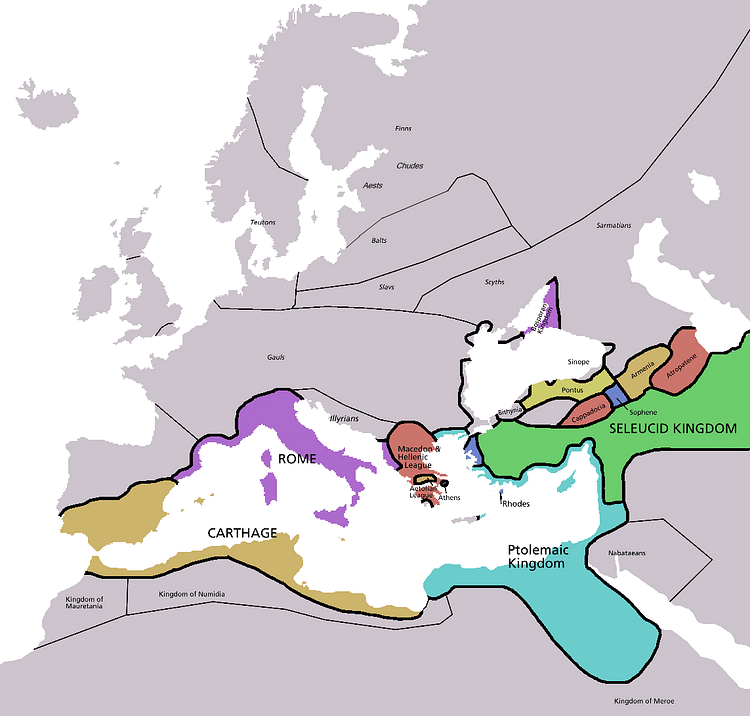
'The Hellenic World ' is a term which refers to that period of ancient Greek history between 507 BCE (the date of the first democracy in Athens ) and 323 BCE (the death of Alexander the Great ). This period is also referred to as the age of Classical Greece and should not be confused with The Hellenistic World which designates the period between the death of Alexander and Rome 's conquest of Greece (323 - 146 - 31 BCE). The Hellenic World of ancient Greece consisted of the Greek mainland, Crete, the islands of the Greek archipelago, and the coast of Asia Minor primarily (though mention is made of cities within the interior of Asia Minor and, of course, the colonies in southern Italy ). This is the time of the great Golden Age of Greece and, in the popular imagination, resonates as 'ancient Greece'.
The great law-giver, Solon, having served wisely as Archon of Athens for 22 years, retired from public life and saw the city, almost immediately, fall under the dictatorship of Peisistratus. Though a dictator, Peisistratus understood the wisdom of Solon, carried on his policies and, after his death, his son Hippias continued in this tradition (though still maintaining a dictatorship which favored the aristocracy). After the assassination of his younger brother (inspired, according to Thucydides, by a love affair gone wrong and not, as later thought, politically motivated), however, Hippias became wary of the people of Athens, instituted a rule of terror, and was finally overthrown by the army under Kleomenes I of Sparta and Cleisthenes of Athens.Cleisthenes reformed the constitution of Athens and established democracy in the city in 507 BCE. He also followed Solon's lead but instituted new laws which decreased the power of the artistocracy, increased the prestige of the common people, and attempted to join the separate tribes of the mountan, the plain, and the shore into one unified people under a new form of government. According to the historian Durant, "The Athenians themselves were exhilarated by this adventure into sovereignty. From that moment they knew the zest of freedom in action, speech, and thought; and from that moment they began to lead all Greece in literature and art, even in statesmanship and war " (126). This foundation of democracy, of a free state comprised of men who "owned the soil that they tilled and who ruled the state that governed them", stabilized Athens and provided the groundwork for the Golden Age.
THE GOLDEN AGE OF GREECE, ACCORDING TO THE POET SHELLEY, "IS UNDOUBTEDLY...THE MOST MEMORABLE IN THE HISTORY OF THE WORLD".
The list of thinkers, writers, doctors, artists, scientists, statesmen, and warriors of the Hellenic World comprises those who made some of the most important contributions to western civilization : The statesman Solon, the poets Pindar and Sappho, the playwrights Sophocles, Euripedes, Aeschylus and Aristophanes, the orator Lysias, the historians Herodotus and Thucydides, the philosophers Zeno of Elea, Protagoras of Abdera, Empedocles of Acragas, Heraclitus, Xenophanes, Socrates, Plato, and Aristotle, the writer and general Xenophon, the physician Hippocrates, the sculptor Phidias, the statesman Pericles, the generals Alcibiades and Themistocles, among many other notable names, all lived during this period. The Golden Age of Greece, according to the poet Shelley, "is undoubtedly...the most memorable in the history of the world" for the accomplishments and advancements made by the people of that time. Interestingly, Herodotus considered his own age as lacking in many ways and looked back to a more ancient past for a paradigm of a true greatness. The writer Hesiod, an 8th century BCE contemporary of Homer, claimed precisely the same thing about the age Herodotus looked back toward and called his own age "wicked, depraved and dissolute" and hoped the future would produce a better breed of man for Greece. Herodotus aside, however, it is generally understood that the Hellenic World was a time of incredible human achievement.
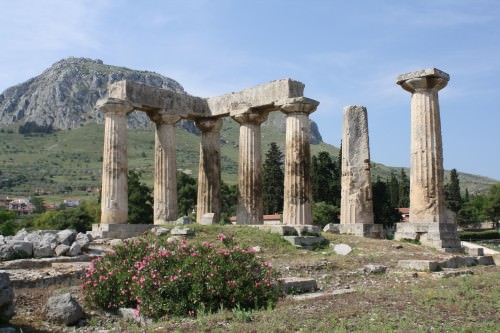
Monolithic Columns, Corinth
Major city-states (and sacred places of pilgrimage) in the Hellenic World were Argos, Athens, Eleusis, Corinth, Delphi, Ithaca, Olympia, Sparta, Thebes, Thrace, and, of course, Mount Olympus, the home of the gods. The gods played an important part in the lives of the people of the Hellenic World; so much so that one could face the death penalty for questioning - or even allegedly questioning - their existence, as in the case of Protagoras, Socrates, and Alcibiades (the Athenian statesman Critias, sometimes referred to as `the first atheist', only escaped being condemned because he was so powerful at the time). Great works of art and beautiful temples were created for the worship and praise of the various gods and goddesses of the Greeks, such as the Parthenon of Athens, dedicated to the goddess Athena Parthenos (Athena the Virgin) and the Temple of Zeus at Olympia (both works which Phidias contributed to and one, the Temple of Zeus, listed as an Ancient Wonder). The temple of Demeter at Eleusis was the site of the famous Eleusinian Mysteries, considered the most important rite in ancient Greece. In his works The Iliad and The Odyssey, immensely popular and influential in the Hellenic World, Homer depicted the gods and goddesses as being intimately involved in the lives of the people, and the deities were regularly consulted in domestic matters as well as affairs of state. The famous Oracle at Delphi was considered so important at the time that people from all over the known world would come to Greece to ask advice or favors from the god, and it was considered vital to consult with the supernatural forces before embarking on any military campaign.
Among the famous battles of the Hellenic World that the gods were consulted on were the Battle of Marathon (490 BCE) the Battles of Thermopylae and Salamis (480 BCE), Plataea (479 BCE,) and The Battle of Chaeronea (338 BCE) where the forces of the Macedonian King Philip II commanded, in part, by his son Alexander, defeated the Greek forces and unified the Greek city-states. After Philip's death, Alexander would go on to conquer the world of his day, becoming Alexander the Great.Through his campaigns he would bring Greek culture, language, and civilization to to the world and, after his death, would leave the legacy which came to be known as the Hellenistic World.
Throne of Montezuma › Antique Origins
Ancient Civilizations
The magnificent stone monument variously referred to as the Monument of Sacred War, the Teocalli of Sacred War, the Temple Stone or, more simply, the throne of Motecuhzoma II ( Montezuma ), the Aztec king ( tlatoani ) who ruled at the time of the Spanish conquest, is covered with relief carvings of symbols, gods and Motecuhzoma himself. The throne, carved in the shape of a pyramid temple, commemorates the New Fire Ceremony of 1507 CE and, through art, demonstrates the inseparable link between fire and water and between this world's rulers and the eternal cosmos. It is one of the masterpieces of Aztec art and can be admired in its permanent home in the National Museum of Anthropology in Mexico City.
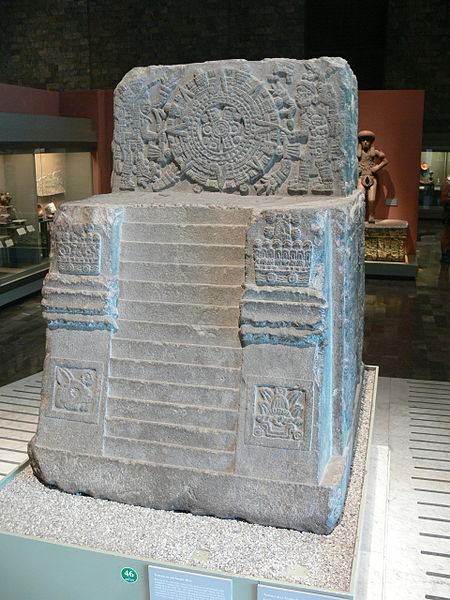
Throne of Motecuhzoma II
PURPOSE
Discovered in 1831CE near the palace of Motecuhzoma II under what is now Mexico City, the throne was carved in 1507 CE from volcanic stone and measures 1.23 metres in height and around 1 metre in both depth and width.The object as a whole celebrates the triumph of the sun and the top is inscribed with the year 2 House which translates as 1345 CE, regarded as the traditional founding date of the Aztec capital Tenochtitlan. The throne appears in the form of a typical Aztec stepped pyramid with the back representing the sacred temple which stood at the top of such monuments. The stone may, in fact, be considered as a votive commemorative or teocalli (meaning 'house of god') of sacred warfare and the New Fire Ceremony ( Toxiuhmolpilia ). This ritual, held only once every 52 years on the completion of the full Aztec calendar cycle, was perhaps the single most important event in Aztec religion and life in general.
THE THRONE APPEARS IN THE FORM OF A TYPICAL AZTEC STEPPED PYRAMID WITH THE BACK REPRESENTING A SACRED TEMPLE.
Presided over by the Xiuhtechutli, the god of fire, the purpose of the ceremony was to ensure the successful renewal (or re-occurrence) of the sun. Atop Mt. Uixachtecatl (or Citlaltepec), near the Aztec capital of Tenochtitlán, priests gathered at midnight and awaited a precise alignment of the stars. Then a sacrifice was made to Xiuhtecuhtli by cutting out the heart of a sacrificial victim. Fire was then kindled inside the open chest cavity and if the fire lit successfully all was well. If the flame did not light then it was believed to signal the coming of terrible monsters, the Tzitzimime, who would roam the darkness eating all mankind.
With the unthinkable possibility that the sun might not actually reappear, every ceremony was a crucial moment in Aztec society, but perhaps the one of 1507 CE was more significant than most. The Aztec empire had suffered several misfortunes leading up to the event, notably a devastating famine and destructive snowstorms, so that a new cycle and a fresh start was just what Motecuhzoma needed. Ultimately, the sun did appear again to welcome in another 52 years of cosmic harmony but, in reality, it was only 14 years later that strangers from the west would bring about the cataclysmic collapse of the Aztec civilization.
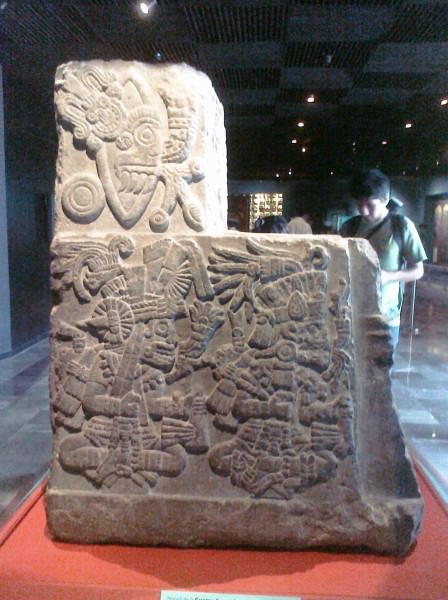
Monument of Sacred War
DETAILS
The twelve steps which approach the seat are flanked by an image of a rabbit on the left signifying the calendar date 1 whilst on the right side reeds represent the date 2. It has been suggested by scholars that these dates represent either the first and last years of the 52-year cycle or the years in which this particular New Fire Ceremony crossed over. Above these symbols, again, one on either side, are representations of cuauhxicalli - the vessels used to hold offerings such as the hearts of sacrificial victims during religious ceremonies. The one on the left has markings indicating a jaguar skin and the one on the right has eagle feathers.
The back of the seat of the throne carries a large sun disk on which are indicated the cardinal and inter-cardinal points, a common motif in Aztec art. On the left of the sun disk stands the figure of Huitzilopochtli, the god of war and the sun, wearing his usual hummingbird headdress and with his left foot in the shape of a fire serpent whilst on the right stands Motecuhzoma II performing a sacrifice to the god. The seat of the throne has a relief of the earth monster Tlaltecuhtli of Aztec mythology. Therefore, when Motecuhzoma sat on the throne, he was in contact with both the earth and sun, and so was fulfilling his role as sacred guardian of both, separating them with his person and preventing the sun from collapsing onto the earth.
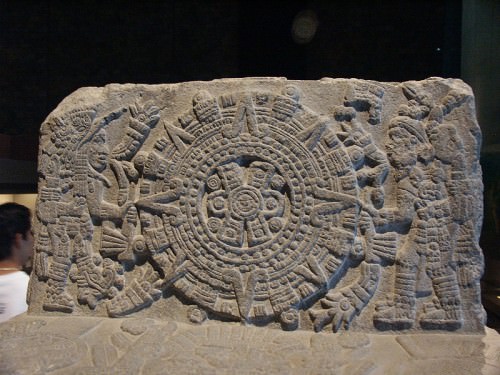
Throne of Motecuhzoma, Detail
The large eagle on the back of the throne reminds of the legend of the founding of Tenochtitlán when Huitzilopochtli indicated the correct site with an eagle sitting on a cactus. The figures are the Aztec people who offer their hearts in sacrifice and homage to their gods and ruler. At the sides of the stone seated gods, each with a tetl or stone symbol on their backs, self-sacrifice blood from their loins, a typical ritual of Aztec religion. The four deities represented are Tlaloc (god of rain), Tlahuizcalpantecuhtli (Dawn), Xiuhtecuhtli (god of fire), and Xochipilli (god of flowers, summer and music). There are also marked the dates 1 Flint and 1 Death and a smoking mirror to represent Tezcatlipoca, the god of destiny. These scenes, therefore, combine with the other relief carvings on all sides of the stone to give compelling testimony of the divine favour enjoyed by Motecuhzoma's reign.
LICENSE:
Article based on information obtained from these sources:with permission from the Website Ancient History Encyclopedia
Content is available under License Creative Commons: Attribution-NonCommercial-ShareAlike 3.0 Unported. CC-BY-NC-SA License